We Must Have STEM for ALL Our Students
A MiddleWeb Blog
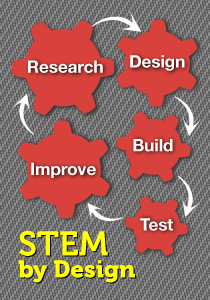 The STEM Ed Shortfall
The STEM Ed Shortfall
Disadvantaged students and minorities face battles on many fronts, and access to STEM education should not be one of them. For years we’ve known about and documented inequities in Science, Technology, Engineering, and Mathematics (STEM) education in the US. In spite of that, those inequities in STEM endure in many school systems.
Now, in today’s economy, when innovation in STEM is most critical to our nation, those least prepared in STEM coursework – minorities and our economically disadvantaged students – are often less prepared for the workforce. Students without STEM learning options are likely to wind up with lower social and economic mobility, be less informed about science and technology, and experience a diminished quality of life.
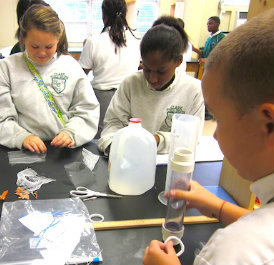
It makes no sense.
STEM education can make a difference
We have evidence that high-quality, project-based curricula such as STEM might narrow the achievement gap for children from low-income backgrounds and other groups who are traditionally underrepresented in STEM fields.
An SRI study, highlighted in MindShift, KQED’s ed blog, described findings from research among 3,000 middle school science students. The study shows that all kinds of kids learn more in science classes with a well-designed, project-focused curriculum. And here’s the clincher – the students from different racial, ethnic, and socioeconomic backgrounds learned at similar rates.
Is anyone really surprised? Of course disadvantaged and minority students can learn at high levels! These students are creative. They can generate a wide range of ideas to solve problems. They can flourish in risk-free climates that allow creativity, imagination, innovation, collaboration and problem-solving.
The middle schoolers in this study were taught using the thinking processes and practices that scientists and engineers use to investigate and solve problems. So STEM curriculum – which uses these inquiry-based lessons – might help to bridge the inequity faced by nearly half (48%) of our public school students.
How can we be sure all students gain STEM access?
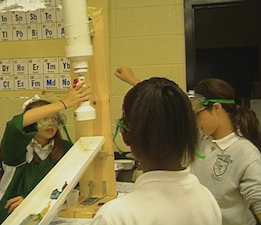
Okay – let’s pretend! Let’s imagine that we can magically create conditions to support good STEM education in classrooms and schools that serve these students. What will we do?
- Provide adequate facilities and resources. For starters, let’s fund all schools equitably and make sure that no schools are under-resourced. I worked for two years with “underperforming” schools. In that capacity I served disadvantaged schools, many of which had no lab facilities, equipment, or technology. No wonder there’s a gap.To make sure our kids have quality STEM education, let’s be sure they are in clean and comfortable facilities. In our schools, we’ll supply necessary curriculum materials in full. Students will have access to the equipment, resources, and experiences that they need. We know that resource inequalities may have cumulative effects as our students’ move through grades K-12 and contribute to learning inequalities. We don’t want that.
- Put strong school leadership in place. Our schools will be led by strong, visionary principals who are knowledgeable and informed about STEM and focused on improving teaching and learning. These principals will have a thorough understanding of what a quality STEM curriculum looks like and communicate that vision to the faculty. They will be flexible, able to restructure the school day as needed, and provide ongoing support.Our principals will believe that all students should experience STEM learning; therefore they will embed STEM into the core math and science classes and not include it as an add-on program only.
Give all students access to well-trained or credentialed teachers. This will be a number one priority for us. Our teachers will experience ongoing professional development in the pertinent subject matter areas, STEM practices, and meeting diverse student needs. They will have opportunities to work together regularly to implement, discuss, and adjust lessons. We may need to provide coaching to help some teachers move from fact-driven curriculum to curriculum that asks students to think at high levels, collaborate, innovate, and problem-solve.Our teachers will understand how to teach an inquiry-based, experiential curriculum that relates to real-world applications, encourages critical thinking, problem solving and teamwork, and goes beyond minimal competencies. We want our teachers and students to work together as active learning partners.
- Involve parents. Let’s involve our parents in ways that are open and welcoming and that provide them with opportunities for learning and involvement. Some of our parents may have had bad school experiences as students. We may need to reach out to them in special ways, provide transportation, visit them, and even take them activities that they can do at home with their children. We will make sure they know what we are hoping to accomplish for their children with a STEM curriculum.
- Use a supportive system of assessment and accountability. In our schools, let’s make sure that teachers aren’t spending valuable time teaching to standardized tests. Let’s use assessment systems that focus on success and growth rather than blame and failure. Our assessments will provide a basis for continuous improvement of the STEM program.
Beyond STEM
By now, some of you may be thinking, “Well, duh . . . those things should be provided in all subject areas and for the entirety of the student’s education experience.” You are completely right, of course. Clearly, STEM subjects are not the only subjects that matter in K-12 education.
So forgive what may seem a narrowly-focused solution for this pervasive problem. The best possible solution would be entire schools with a well-designed and well-implemented inquiry-based, experiential curriculum. This would make a tremendous difference for disadvantaged students.
STEM for Equitable Success
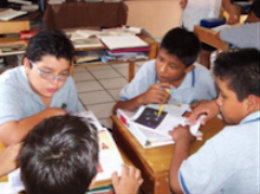
And STEM literacy offers all students a foundation that they can use in their personal and professional lives, whether or not they adopt STEM careers.
What are your schools doing to address the STEM advantage gap?

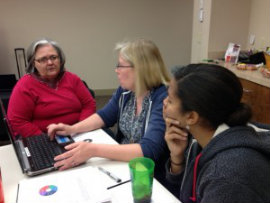 Give all students access to well-trained or credentialed teachers. This will be a number one priority for us. Our teachers will experience ongoing professional development in the pertinent subject matter areas, STEM practices, and meeting diverse student needs. They will have opportunities to work together regularly to implement, discuss, and adjust lessons. We may need to provide coaching to help some teachers move from fact-driven curriculum to curriculum that asks students to think at high levels, collaborate, innovate, and problem-solve.Our teachers will understand how to teach an inquiry-based, experiential curriculum that relates to real-world applications, encourages critical thinking, problem solving and teamwork, and goes beyond minimal competencies. We want our teachers and students to work together as active learning partners.
Give all students access to well-trained or credentialed teachers. This will be a number one priority for us. Our teachers will experience ongoing professional development in the pertinent subject matter areas, STEM practices, and meeting diverse student needs. They will have opportunities to work together regularly to implement, discuss, and adjust lessons. We may need to provide coaching to help some teachers move from fact-driven curriculum to curriculum that asks students to think at high levels, collaborate, innovate, and problem-solve.Our teachers will understand how to teach an inquiry-based, experiential curriculum that relates to real-world applications, encourages critical thinking, problem solving and teamwork, and goes beyond minimal competencies. We want our teachers and students to work together as active learning partners.


































Hi again, Ann. Excellent. Don’t forget the Technology / Technology-Engineering teachers – those well-versed in project-based facilities, equipment and resources. The “third leg” of STEM. See http://www.iteea.org The conference next spring focuses on STEM integration. I’m going to use this post for our Press Conference tomorrow. Still trying to get a proper STEM facility for our high school remodel…making progress, I think!
Thanks, Donna – I’ve been keeping up with some of your progress – so glad to see folks like you continuing to work for equal access! I would love to hear from some technology/technology-engineering teachers who would share some of what they are doing with students. If you know some who would take a minute to respond, give them the link to this post.
Thanks!! Keep on moving forward.
A support system is essential to a student’s growth in both the classroom and in life. It helps to involve parents and bridges all parts of the student’s life. Very interesting article and really piqued my eyes on how it works with students.